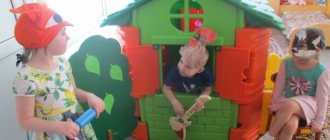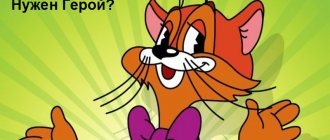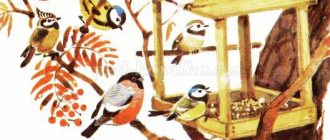Thematic week “Visiting a fairy tale.” Senior group
Topic of the week: “The fairy tale is a lie, but there is a hint in it!
A lesson for a good fellow” for children 5-6 years old Description : this material will be of interest to teachers of senior and preparatory groups, primary school teachers, and mothers of many children. Goal : expanding children's knowledge about Russian folk tales Tasks: - to reveal to children the concepts of “fairy tale”, “folk tale”; - learn to tell fairy tales, retell them by role; — introduce the artist-illustrator of fairy tales Viktor Mikhailovich Vasnetsov; - promote the development of artistry, emotionality, through playing the role of a hero; — cultivate a love for the native language through reading and knowledge of Russian folk tales; - to cultivate an emotional perception of the content of a fairy tale.
MONDAY
Conversation “The fairy tale begins from the beginning, is read to the end, and is not interrupted in the middle”
Goal: teaching the rules of listening to a fairy tale.
Objectives: - clarify and consolidate the understanding of “fairy tale” as a work and as a term; - promote active listening from start to finish without interrupting; - promote the development of logical thinking; - contribute to the development of respect for the narrator, the speaker. Role-playing game: “Book Hospital”
Purpose: teaching to take care of books.
Objectives: - learn to “fix” a “sick” book; — continue to teach how to use scissors correctly and carefully glue; — promote the development of creative abilities; - contribute to the education of accuracy and thrift. Creative activity:
Drawing: “Alyonushka by the Pond” based on the painting by Viktor Mikhailovich Vasnetsov Modeling: “Little Goat”
Theatrical activity:
acting out mini-scenes based on a fairy tale
D/i:
“Which fairy tale is the hero from?”, “Guess the hero”
Art reading:
“ Sister Alyonushka and brother Ivanushka" (magical fairy tale) Reproduction of the painting: "Alyonushka" by Vasnetsov
Work with parents:
"My favorite book of fairy tales": children bring books from home and a mini-library or mini-store is compiled.
TUESDAY Conversation: “Folk tale - magical, about animals, everyday”
Goal: expanding the understanding of a folk tale.
Objectives: - give the concept of “folk”; - to develop knowledge about the division of fairy tales into three types: magical, about animals, everyday; — promote the development of children’s speech activity; — to promote interest in Russian folk art and pride in one’s people. Excursion to the library. Role-playing game “In the Library”
Goal: to introduce children to visiting the library Objectives: - to teach them to play the role of a librarian and reader, to conduct a competent dialogue;
- promote the development of artistry and creative activity; — to promote interest in the library as a home where books live. Creative activity:
Drawing: based on the fairy tale “Crane and Heron” Modeling: “Plate and Jug” Application: “Jug Decoration”
Theatrical activity:
acting out mini-scenes based on the fairy tale Goal: development of artistic abilities.
D/i:
“Describe the hero”
Fiction reading:
“The Crane and the Heron” (a fairy tale about animals) Examination of illustrations for the fairy tale.
Conversation: “Book illustration” Purpose: to familiarize yourself with the concept of “illustration” Work with parents:
please take your children to a bookstore.
WEDNESDAY Conversation “Heroes of fairy tales - what are they?”
Goal: expanding children's knowledge about the character of heroes.
Objectives: - learn to name the distinctive features of heroes, naming positive and negative qualities; - learn to describe actions and explain their meaning; – promote speech development and expansion of children’s vocabulary; - promote the development of correct behavior, a sense of compassion for the weak, and a desire to help. Role-playing game: “Bookstore”
Goal: developing children’s social experience through play activities.
Objectives: - teach how to properly conduct dialogue in a store; - learn to play the roles of seller and buyer; — promote the development of creative abilities; — promote a culture of behavior in the store. Creative activity:
Drawing: depiction of negative and positive characters Modeling: “Pot of Porridge” Application: “Golden Scallop Cockerel”
Theatrical activity:
acting out mini-scenes based on a fairy tale Goal: development of artistic abilities.
D/i:
printed board game “Tale by Tale”, “Which hero does the object belong to?”
Literary reading:
“Porridge from an Axe” (everyday fairy tale), “Flourish Hare”, “Cowardly Hare” and “Brave Hare”, etc.
THURSDAY Conversation “Vasnetsov - artist-illustrator of fairy tales”
Goal: introducing children to illustrators Tasks: - repeat the concept of “illustration”, “artist-illustrator”;
- give the concept of “reproduction”, “picture”; - learn to look at a picture and describe it; — promote the development of children’s speech activity; - promote interest in artistic creativity. Role-playing game: at the request of the children
Goal: development of children's creative activity
Creative activity:
Drawing: based on any of the selected fairy tales Modeling: based on any of the selected fairy tales Application: based on any of the selected fairy tales
Theatrical activity:
acting out mini-scenes based on the fairy tale Goal: development creative and artistic abilities of children.
Fiction reading to choose from:
“The Snow Maiden”, “Ivan Tsarevich and the Gray Wolf”, “Underground Kingdoms”.
Conversation “What do fairy tales teach?”
Goal: generalization and consolidation of acquired knowledge from fairy tales. Objectives: - learn to generalize acquired knowledge;
- promote the development of memory and observation; — to promote the cultivation of love for Russian folk art. Role-playing game: at the request of the children
Goal: development of children's creative activity
Creative activity:
Drawing: plot from a fairy tale to choose from.
Modeling: “Frog” Application: “Swans in the Pond” Theatrical activity:
acting out mini-scenes based on a fairy tale Goal: development of children’s creative and artistic abilities.
D/i:
“Guess the riddle”, assemble a picture from puzzles.
Fiction:
“The Frog Princess” Consideration of Vasnetsov’s reproduction. Throughout preschool age, children love to listen to fairy tales, retell them and write their own. Fairy tales in general contribute to the development of fantasy, imagination, creative thinking, make the child’s world magical, teach kindness and responsiveness, compassion and understanding. Read fairy tales more often! I hope my material will be interesting and useful to all those who work with children.
We recommend watching:
Thematic day in the preparatory group on the topic “Insects” Notes for a mathematics lesson in the senior group “Kolobok’s Journey” Notes on speech development in the senior group “Poultry” Thematic week “Wintering birds” in kindergarten. Second early age group
Similar articles:
Cultivating cognitive interest in social reality in children of senior preschool age
What do fairy tales teach for children and what fairy tales are best to read to a child?
We all grew up on fairy tales. These wonderful stories, in which magic was intertwined with intrigue, good always defeated evil, numerous adventures and terrible dangers awaited the heroes, excited our imagination and made our dreams more colorful and exciting. As a child, our parents or grandparents read to us, and now many of us read fairy tales to our own children.
Fairy tales for babies are not just a good time or a way to put children to sleep, they are a very effective and yet unobtrusive method of teaching. The benefits of reading are known to everyone, and this applies not only to some educational materials, but also to the simplest invented stories. A daily bedtime story for a child can do wonders for their development. He will become more attentive and diligent, because listening to the story to the end requires a lot of patience. The vocabulary will be replenished with a wide variety of new words and speech patterns. He will learn to reflect and think about the consequences of his own and others' actions. Not to mention how fairy tales develop imagination, relax and even motivate. Children who learn to love fairy tales as children will undoubtedly carry this love of books into adulthood.
WHAT DO FAIRY TALES TEACH?
Fairy tales give a child a first impression of the world and human relationships. Yes, we are talking about made-up worlds and made-up people, but the situations in which the heroes of children's stories find themselves invariably carry some kind of moral or clear example for the younger generation. The fact that good always triumphs over evil is perhaps the worst cliché for adults, but for children it is the only correct option. They often associate themselves with heroes not only of books, but also of comics, who tirelessly save people and fight evil.
Many of our ideals and moral values come from fairy tales that taught us from a young age what is good and what is bad:
- Kindness, justice, generosity, selflessness are the qualities of a real hero. Children who want to be like their favorite hero will strive to develop good qualities in themselves
- Villains sooner or later have to answer for their actions. In fairy tales, villains are always deceitful, cowardly and cruel people. And always, without exception, their atrocities come to an end. Simply put, they show children how not to behave and that bad behavior results in punishment.
- For the heroes, too, not everything comes easy right away; they have to overcome difficulties along the way. The fact that even mighty heroes and princesses have to work and make a lot of effort to win teaches children that nothing in life is given for nothing, that hard work is needed even for those who are naturally talented and strong.
- Anyone can become a hero. Often in fairy tales, the hero becomes a good-natured and simple-minded guy, whom everyone made fun of at the beginning. People who are often underestimated can also triumph, the main thing is not to pay attention to ridicule and not allow others to lower themselves and their abilities.
- Strength isn't everything. Of course, everyone loves fairy tales about heroes who can uproot a hundred-year-old oak tree with one hand and slay a dragon with the other. But physical superiority does not always help find a way out of the situation. It is important to be quick-witted and smart to be able to outsmart your enemies.
- It is not always possible to cope alone. The ability to make friends, help each other and work in a team is one of the most important knowledge that a growing member of society needs. Whatever one may say, a person constantly has to communicate with someone, work with someone and get along with someone, which is why fairy tales so often emphasize teamwork, letting the child understand that no matter how strong the main character is, he also needs help and support from friends.
WHAT ARE THE BEST FAIRY TALES TO READ?
It's never too early to start reading fairy tales to your child. Fairy tales for children vary by age, but it’s best to start as early as possible. Of course, at the very beginning, the newborn will not understand the meaning of your words, so it doesn’t matter what kind of fairy tales you read to him. A mother's or father's soothing voice will help the child relax. Until one year of age, you can recite or hum little rhymes, songs, and show your baby color pictures. Then move on to the simplest classic stories like everyone’s favorite “Kolobok”. Stories about animals with beautiful illustrations are best.
After 3 years, you can already bring people into the picture, how they interact with animals, with each other. At the same time, the plot still remains simple and clear with a predictable happy ending. From the age of 4, you can already diversify your stories a little. Bring a little magic and wonder, show the child new worlds where everything is different. And from the age of 5, move on to more complex and exciting fairy tales with adventures, heroes, wizards and other fairy-tale paraphernalia.
If you run out of books or collections, you can always find new fairy tales for children on the Internet. Or try to come up with a story together.
Remember that fairy tales are a great opportunity to spend time with your children. Don't brush them off if they ask to read a story, take the time and chances are you'll have as much fun as your little ones.
Do you remember fairy tales? Take the test to test your knowledge of fairy tales that you've probably known since childhood!
Source: pandaland.kz
Why should we read fairy tales to children?
The content of the article:
Fairy tales are important because they create in our subconscious a form of deep fears and dreams of life through fantasy. Many child psychologists claim that fairy tales teach children to realistically imagine life, to feel the experiences, emotions, and reactions that shape us throughout our lives. In fairy tales you understand that this is not real; you know that characters are unfamiliar creatures, but they are always able to evoke in us certain feelings that are very important for our future life. Fairy tales give children the right path through stories that help formulate perceptions of the world.
The simplest story about the actions of the characters helps children worry, sympathize, think, and reflect. Fairy tales help children feel safe and comfortable, entering into a fairy tale within themselves. If a character is experiencing difficulties, then children can be confident that everything will be fine for this character, according to their logic, which was formed due to the movement of events. Evil characters make life more difficult in a fairy tale, but they help to learn important life lessons. For a child, they often describe a world with dishonest, evil, aggressive people capable of meanness - and a child’s bright world must be prepared for this. He must understand that not everyone is good, and he needs to take a closer look at the person so as not to fall for his tricks in the future. We should not tell children that there is always an easy and airy life. It is important that they understand that there are many people who will sometimes put a spoke in the wheel, and not to forget that there are other good and honest people who need to be trusted, befriended and helped.
At the end of every children's fairy tale, everything is always good: good characters get what they wanted; and the wicked receive punishment for their actions.
- Good characters teach you to be a good, honest, kind, true person.
- Evil ones allow us to understand that in life not everything is always great, and things may not always go the way we want, but by doing the right things we get our “reward” in life.
Such stories are calming, make you think, and this, of course, affects the little person’s perception of the world.
Source of valuable knowledge
Fairy tales teach us everything that is so lacking in our modern technocratic world. It is a pity that these days children begin to get acquainted with the world around them not through the plots of fairy-tale adventures, but through mini-versions in videos on the computer or cartoons on TV screens. And these are not even always cartoons based on classic fairy tales. It is impossible to live without a miracle! After all, only by immersing yourself in this enchanting and magical world can you learn to appreciate friends, not be afraid of difficulties, and understand that good always comes back in kind .
In fairy tales everything is simple and clear. In life, everything is much more complicated and confusing, there is no clear line between white and black, there are many shades, and it is also difficult to draw a line between good and evil. But if people apply in life the wisdom, skill and experience gained from fairy tales, so to speak, basic knowledge, then getting out of difficult life situations will be much easier. And, the main conclusion, since fairy tales have reached our time, it means that this genre is really worth everyone’s attention and is a source of valuable knowledge.





